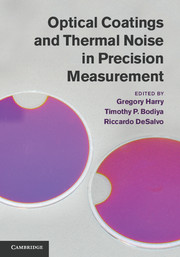Book contents
- Frontmatter
- Contents
- List of contributors
- Foreword
- Preface
- 1 Theory of thermal noise in optical mirrors
- 2 Coating technology
- 3 Compendium of thermal noises in optical mirrors
- 4 Coating thermal noise
- 5 Direct measurements of coating thermal noise
- 6 Methods of improving thermal noise
- 7 Substrate thermal noise
- 8 Cryogenics
- 9 Thermo-optic noise
- 10 Absorption and thermal issues
- 11 Optical scatter
- 12 Reflectivity and thickness optimization
- 13 Beam shaping
- 14 Gravitational wave detection
- 15 High-precision laser stabilization via optical cavities
- 16 Quantum optomechanics
- 17 Cavity quantum electrodynamics
- References
1 - Theory of thermal noise in optical mirrors
Published online by Cambridge University Press: 05 January 2012
- Frontmatter
- Contents
- List of contributors
- Foreword
- Preface
- 1 Theory of thermal noise in optical mirrors
- 2 Coating technology
- 3 Compendium of thermal noises in optical mirrors
- 4 Coating thermal noise
- 5 Direct measurements of coating thermal noise
- 6 Methods of improving thermal noise
- 7 Substrate thermal noise
- 8 Cryogenics
- 9 Thermo-optic noise
- 10 Absorption and thermal issues
- 11 Optical scatter
- 12 Reflectivity and thickness optimization
- 13 Beam shaping
- 14 Gravitational wave detection
- 15 High-precision laser stabilization via optical cavities
- 16 Quantum optomechanics
- 17 Cavity quantum electrodynamics
- References
Summary
Introduction
Mechanical and optical thermal noises play an important role in many precise optomechanical experiments, in which positions of test bodies are monitored by laser beams. Much of the initial experimental and theoretical research in this area was driven by the physics of gravitational-wave interferometers, where thermal fluctuations are expected to be the dominant source of noise in the frequency band between about 10 and 100 Hz (Harry et al., 2002) (see Chapter 14). Recently, it has become clear that controlling thermal noise will be key in several other fields, notably in designing laser cavities with higher frequency stability (Numata et al., 2004) (see Chapter 15), in reaching the quantum limit in macroscopic opto-mechanical experiments (Kippenberg and Vahala, 2008) (see Chapter 16), and in cavity QED experiments (Miller et al., 2005) (see Chapter 17). In this chapter we review the statistical-mechanics formalism which is used to theoretically calculate mechanical and optical thermal noise. For completeness, we also add a discussion of another important limitation in mechanical measurements, the so-called Standard Quantum Limit.
Theory of mechanical thermal noise
The theory of time-dependent thermodynamical fluctuations has been extensively developed for the past century. One of the fundamental results in this field is the Fluctuation–Dissipation Theorem, which was originally formulated by Callen and Welton (1951). Callen and Welton's insight was that the intensity of random fluctuation in some macroscopic degree of freedom of the thermodynamic system was proportional to the strength with which was coupled to the microscopic degrees of freedom of the heat bath.
- Type
- Chapter
- Information
- Publisher: Cambridge University PressPrint publication year: 2012



